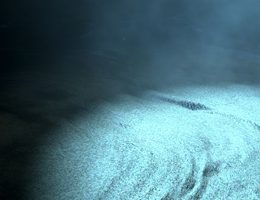Scavenging to survive below the seafloor
Microorganisms living in the sediments buried below the seafloor obtain their nutrients by using secreted enzymes to degrade adsorbed detritus. A new study shows that in order to survive for long time scales, microorganisms eat one another after they die.
25.10.2017
The sediments that underlie the world’s oceans harbor a diverse array of microbial communities. Many of the organisms in this cold, anoxic environment depend for their survival on organic matter. Indeed, marine sediments constitute the largest reservoir of organic carbon on Earth, and understanding the dynamics of its recycling is vital for the reliable assessment of the impact of global warming. Much of the fixed carbon found in the sediments consists of detrital proteins and carbohydrates. However, little is known about the microbial groups that are responsible for the breakdown of carbon compounds in the subseafloor. To help fill this gap in our knowledge, William Orsi, Professor of Geomicrobiology in the Department of Earth and Environmental Sciences at LMU, set out to characterize these groups by analyzing, at the genetic level, the enzymes that they secrete into their environment. The results of the study have now been published online in the journal Nature Microbiology.
 Microorganisms living deep below the seafloor secrete enzymes to degrade organic matter deposited in the sediments. Image: alswart / fotolia.com
Microorganisms living deep below the seafloor secrete enzymes to degrade organic matter deposited in the sediments. Image: alswart / fotolia.com
Microorganisms use extracellular enzymes to catalyze the chemical degradation of organic, carbon-containing substances in the surrounding medium. The resulting breakdown products are taken up by specialized transport proteins and serve as energy sources and building blocks for cell growth. All enzymes destined for export from cells contain a short, defined sequence of amino acids that serves as an identification tag, which is recognized by the secretory apparatus that enables them to gain access to the cell exterior. Environmental RNA fragments recovered from sediments can be amplified and analyzed in the laboratory, thus enabling the sequences of these tags, that encode information for producing the enzymes themselves. “Using a novel bioinformatic method, we searched for evolutionarily conserved, and hence functionally important, amino-acid sequence motifs within these recognition sequences. In this way, we were able, for the first time, not only to use genetic data to deduce enzyme functions, but also to specifically identify those enzymes that are secreted by cells that live in these sediments,” Orsi explains.
Orsi and his colleagues made use of sequence data that had been obtained in an earlier study of environmental RNA recovered from a deep-sea drilling site off the coast of Peru. The new results show that bacteria, archaea and fungi buried in the sediments at the bottom of the sea produce and secrete a unique constellation of enzymes. These catalysts are capable of degrading biomolecules that are associated with the sedimentary deposits, such as carbohydrates, lipids and proteins – but they can also scavenge nutrients from dead cells. “Many of the enzymes synthesized and secreted by fungal cells specifically attack the cell walls of archaea, while many of the extracellular enzymes released by bacteria can degrade the cell walls of fungi,” Orsi says. “In other words, different classes of microbes apparently cannibalize one another’s ‘carcasses.’” Presumably, the microorganisms utilize this ‘necromass’ as a source of carbon and energy, which enables them to survive in this hostile anoxic zone, far beyond the reach of sunlight. – The oldest sediments found in the drill core were recovered from a depth of 159 meters below the seafloor and are 2.8 million years old.
The researchers now want to know how much carbon is recycled by the various groups of organisms, in order to estimate their individual contributions to the global carbon cycle. “Our data could then be incorporated into biogeochemical models, which would enhance the predictive power of such models,” Orsi says.





